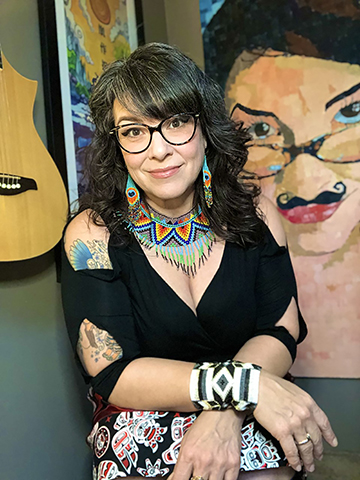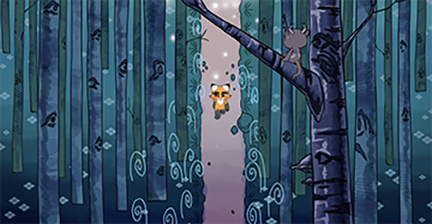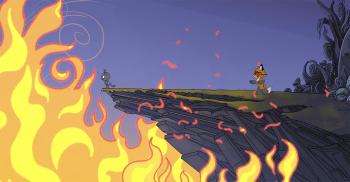Image Caption
Local Journalism Initiative Reporter
Windspeaker.com
Qaqsoss Naka Wahantuhsis (Fox & the Tiny Demon) is a new animated film directed by award winning animator, director and artist Tara Audibert, who has ties to Neqotkuk (Tobique First Nation) through her mother.
The film addresses issues of mental health while preserving Indigenous culture and language. It is the first animated feature film in Wolastoqey, an Algonquian language spoken by the Wolastoqiyik (Maliseet/Malecite) people.
The film is narrated by Audibert's great aunt Carole Polchies of Woodstock First Nation, who is one of the few remaining fluent Wolastoquey speakers. Audibert has used her aunt’s voice in other films to tell “Indigenous stories that I've heard all my life, and then I animated them.” Audibert has “grown up to appreciate the stories even more. You hear them over and over and over again, but these stories change every time you hear them, and depending on who’s listening, as well.”
Audibert takes the task of creating from Wolastoqey stories seriously.
“I question a lot, because I am taking these stories that are supposed to be passed down verbally, but I want to preserve them, and I want to share them,” she said.
“That's a part of how I can be a part of reconciliation. My family is willing to share, and I have the ability to share these a little bit wider.”
For this project, Audibert wrote the story and Polchies translated it and narrated as the storyteller of the film.
“Some of the words were too modern. She had to think of how to combine existing words to capture the meaning,” said Audibert. That’s when the work of her great-grandfather, Dr. Peter Lewis Paul, comes in. He was awarded the Order of Canada a few months before he passed in 1987 for his work to preserve the language, including writing a Wolastoquey dictionary.

Finding ways to talk about mental health
Audibert was inspired by classic animated films such as Watership Down, which dealt with deeper subject matter.
“It's all about these animals and we're telling this story. There is the reality of the human world that's in there, but we're looking at it through the eyes of the animals,” she said of that film.
Audibert seeks to create a similarly impactful and meaningful experience for young audiences. The story of Fox & the Tiny Demon explores themes of mental health, depression, and the intergenerational trauma of residential schools. Audibert approaches these heavy topics through an animated, child-friendly lens that allows for open-ended discussion.
“Those are very heavy things. How do you talk to children about those things?” So Audibert created a story and a space where viewers can be curious about a character’s actions.
“Then you can have a conversation that's not based around my mental health or your mental health or a specific person's mental health. It's about the health of these characters. And it doesn't even have to be about mental health. ‘Why do you think they did that? Why do you think they did it’? There can be a conversation that doesn’t have to be so heavy.”
Audibert’s mom was a day school survivor, and the filmmaker reflects on the ongoing impacts. “It's so much to piece together, and I think that a lot of times it's hard to talk about these things. And how can we frame them?”
Finding a way to talk about the impacts was part of her idea behind the film, Audibert said.
“That it's continuing to persist because of the third, second, third generations that are still suffering, not knowing why your parents were unable to do things that are on the TV of a “normal family. I wanted to talk about what happens when you have mental illness. and you have to live with someone that has mental illness? And you don't have a choice when you're a kid. You just have to live with them until you don't. But can we talk about that in some way?”
Audibert sees artists as “the counterculture, the rebels. We're the ones that are supposed to stand up to everything that is questionable.”
By lifting up a mirror to society, people can see things from different perspectives, she said.
“I think that's what most artists are hoping to do, is just to impart a little bit and share, because I think many artists are on the outside looking in, or we're on whatever that outer edge is. And I think that's an important place to be, because that's where we're going. She said that once others reach the edge where artists are, artists expand beyond.
“And then once people get there and that's the norm, then artists have to move out further and see what's out there again and then show that back. There's no way to get to a better place without that extreme,” said Audibert.
“I think to be able to change people's minds is a large thing. And then the artist keeps going, keeps forward with the mirror reflecting back, and that's our job constantly.”

Storyteller first
Audibert knew she was an artist since she was two years old, and she chuckles about the early manifestations of that creative impulse.
“I got into trouble a lot,” from drawing on her wallpaper to figuring out how to draw characters from cartoons.
She paused the VCR and wrapped Saran Wrap over the TV.
“I got this brilliant idea. I'm going to put Saran Wrap over and I trace it, and then I can put it on paper and trace it off there, and I'll have a copy of what it looks like,” she said. “Little did I know that permanent marker goes through. There's a reason not to do that,” she laughed. “It went right on the actual TV. I got in a lot of trouble for trying to trace stuff from the Flintstones.”
Audibert keeps adults in mind as much as children when making her films.
“Why wouldn’t I want to make something that’s good for everyone?”
She recalls watching cartoons with her younger sister. She knows parents are watching alongside their young ones.
“I hope people will want to watch (Fox & the Tiny Demon) more than once because there's so many little things included in the backgrounds and in the meaning of it,” Audibert said. Similar to listening to the variations of her great aunt’s traditional stories, “Maybe each time they can find something new or different.”
The film was produced on a small indie budget with a minimal crew of 40, which is “unheard of in animation,” she said. Audibert is grateful for the dedicated team that connected deeply with the project's themes and went above and beyond.
“They gave far more than they were paid for. And everyone in the crew told me they found this story very meaningful to them personally.”
“And I was just kind of amazed because there it is, right there. That’s part of reconciliation,” said Audibert. She’s still looking for a distributor for Qaqsoss Naka Wahantuhsis, and the team is preparing to submit to film festivals in addition to having local screenings and the upcoming premiere in Miramichi, New Brunswick on April 19 at 2 p.m. at the Cineplex Miramichi.
Local Journalism Initiative Reporters are supported by a financial contribution made by the Government of Canada.

